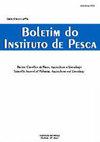Sexual maturity of Callinectes danae and C. ornatus from Paraguaçu river estuary, Bahia state, Brazil
IF 0.6
4区 农林科学
Q4 FISHERIES
引用次数: 0
Abstract
Callinectes danae and C. ornatus are economically important species in several countries, including Brazil. Therefore, this study aimed to estimate the L50 of these species using morphological, morphometric, and physiological data. The estimated values were statically compared and results from previous studies were analyzed to verify latitudinal variations among the sizes of sexual maturity at different latitudes of the Brazilian coast. Individuals were monthly collected in the Paraguaçu River estuary from August 2013 to July 2014, using cage traps. L50 estimates for C. danae were morphological=55.80 mm, morphometric=59.04, mm, and physiological=60.41 mm for males and morphological=54.63 mm, morphometric=55.33 mm, and physiological=57.29 mm for females. Considering C. ornatus, estimates were morphological=42.63 mm, morphometric=50.81 mm, and physiological=43.95 mm for males and morphological=42.33 mm, morphometric=42.75 mm, and physiological=40.43 mm for females. Our results indicated that the minimum catch sizes should be equal to 61.00 mm for C. danae and 51.00 for C. ornatus and that the mesh of traps used by fishermen must be adjusted to prevent the capture of immature animals.巴西巴伊亚州巴拉圭帕拉帕苏河河口地区绵蚧和花蚧的性成熟
在包括巴西在内的一些国家,花线蜂和C. ornatus是经济上重要的物种。因此,本研究旨在利用形态学、形态计量学和生理学数据来估计这些物种的L50。对这些估计值进行了静态比较,并对以往研究结果进行了分析,以验证巴西海岸不同纬度地区性成熟大小的纬度变化。2013年8月至2014年7月,采用笼诱法每月在巴拉圭河河口采集个体。雄性的L50分别为形态学=55.80 mm、形态学=59.04 mm和生理=60.41 mm,雌性的L50分别为形态学=54.63 mm、形态学=55.33 mm和生理=57.29 mm。雄性的形态值为42.63 mm,形态值为50.81 mm,生理值为43.95 mm;雌性的形态值为42.33 mm,形态值为42.75 mm,生理值为40.43 mm。结果表明,丹纳绒螯蟹的最小捕获尺寸应分别为61.00 mm和51.00 mm,并应调整渔人使用的渔网,以防止捕获幼体动物。
本文章由计算机程序翻译,如有差异,请以英文原文为准。
求助全文
约1分钟内获得全文
求助全文
来源期刊

Boletim do Instituto de Pesca
FISHERIES-ZOOLOGY
CiteScore
0.80
自引率
0.00%
发文量
24
审稿时长
>12 weeks
期刊介绍:
To publish original articles of research and short communications in the following áreas: Fisheries, Aquaculture, Zootechnology, Limnology, Oceanography, Biology and Pathology of aquatic organisms. The publication depends on the approval of the Editorial Board, based on the peer review.
 求助内容:
求助内容: 应助结果提醒方式:
应助结果提醒方式:


